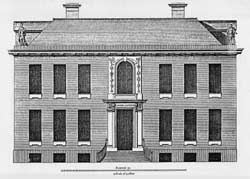Orleans House
'a vast esteat to entertain soe many'
1710

A dwelling house has occupied this site since the 16th century. During the 17th century the estate, crown property, was known as the Queen's Farm. In the early 18th century, James Johnston (1643 - 1737) Secretary of State for Scotland acquired the land. He demolished the old house and commissioned John James (who subsequently rebuilt the nave and chancel of St Mary's Church, Twickenham) to design his new house. It was a rectangular brick building with a central feature in Portland stone. The Octagon was built as a garden pavilion, in brick with Portland stone dressings and surmounted by urns.

Gardening and entertaining
Johnston was a keen gardener. His gardens included two rectangular canals, a mount with an icehouse, an avenue flanked by vines, a parterre, a kitchen garden, a pleasure garden, a wilderness, a Grotto and a fruit garden. He entertained widely. Lady Wentworth noted that he had …a vast deal of company dayly, hear is hardly a day that he has not a coach and six horsis at his doar, and some timse twoe or three more. Sure he must have a vast esteat to entertain soe many, and he has aboandenc of men at work in the grownd before his hous……

Later residents - Orleans House
After Johnston's death the property passed to George Morton Pitt, MP for Pontefract. From 1764 until 1792 the house was occupied by Admiral Sir George Pocock. Perhaps the most famous resident of the property was Louis Philippe Duc d'Orleans, (later King of France) who rented the house during his exile from France. Johnston's house became known from then on as Orleans House.
Later owners included Alexander Murray MP for Kirkudbright, Lord Morley and Henri Duc d'Aumale, the fourth son of the late King Louis Philippe. In 1877, John Dugdale Astley purchased the house and converted it into a luxurious sports and social club which was not a success and soon closed. The last private owners were the Cunard family. The 18th century house had remained virtually unchanged but in 1910 the property was broken up and sold.
Demolition of the house
In 1926 a firm of ballast and gravel merchants demolished the house and other buildings. Attempts to extract gravel were not successful. At the same time, the Octagon, adjacent wings and the stable block were purchased by the Hon Mrs Levy, later the Hon Mrs Nellie Ionides and saved from demolition. She was a great collector and on her death in 1962 she left the remaining property and her picture collection to the Borough.




